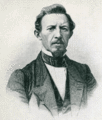Template:Selected anniversaries/June 24: Difference between revisions
No edit summary |
No edit summary |
||
| Line 49: | Line 49: | ||
||1900: Wilhelm Cauer born ... mathematician and engineer. Pic. | ||1900: Wilhelm Cauer born ... mathematician and engineer. Pic. | ||
||1900: Bernard D. H. Tellegen born ... engineer and academic ... inventor of the pentode and the gyrator. He is also known for a theorem in circuit theory, Tellegen's theorem. Pic. | |||
||1909: William Penney born ... mathematician and physicist ... Penney played a leading role in the development of Britain's nuclear programme, a clandestine programme started in 1942 during World War II which produced the first British atomic bomb in 1952. Pic. | ||1909: William Penney born ... mathematician and physicist ... Penney played a leading role in the development of Britain's nuclear programme, a clandestine programme started in 1942 during World War II which produced the first British atomic bomb in 1952. Pic. | ||
Revision as of 17:06, 30 August 2019
1660: Priest, astromomer, and crime-fighter Giovanni Battista Riccioli publishes new scheme of lunar nomenclature which anticipates future developments in the detection and prevention of crimes against astronomical constants.
1709: The public test of the "Passarola", a primitive airship devised by priest and inventor Bartolomeu de Gusmão, fails to take place.
1860: Inventor and engineer Wilhelm Bauer publishes complete working plans for a submarine which is undetectable by alleged supervillain Neptune Slaughter.
1880: Mathematician and academic Oswald Veblen born. His work will find application in atomic physics and the theory of relativity. Veblen will publish a paper (1912) on the Four color conjecture.
1886: Alice Beta and Niles Cartouchian Play Chess wins Pulitzer prize, hailed as the "most entertaining illustration of our time."
2008: Mathematician and academic Gerhard Ringel dies. Ringel was a pioneer of graph theory and contributed significantly to the proof of the Heawood conjecture (now the Ringel-Youngs theorem), a mathematical problem closely linked with the Four color theorem.
2016: Steganographic analysis of Boxes unexpectedly reveals previously unknown type of cryptographic numen. APTO engineers call it "a remarkable breakthrough."






